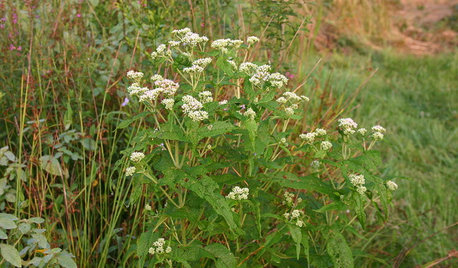Suggestions for keeping bugs off broccoli
Creativeguy_z6_CT
11 years ago
Related Stories

COOL-SEASON CROPSCool-Season Vegetables: How to Grow Broccoli
Packed with vitamins, broccoli is a nutritional powerhouse and is easy to grow in a fall or spring garden
Full Story
GARDENING AND LANDSCAPINGBreezy and Bug-Free Modern Porches
Screening keeps pests out of these diverse porches across the U.S., while thoughtful designs keep them visually appealing
Full Story
EXTERIORSCurb Appeal Feeling a Little Off? Some Questions to Consider
Color, scale, proportion, trim ... 14 things to think about if your exterior is bugging you
Full Story
GARDENING AND LANDSCAPINGBid Bad Garden Bugs Goodbye and Usher In the Good
Give ants their marching orders and send mosquitoes moseying, while creating a garden that draws pollinators and helpful eaters
Full Story
GARDENING GUIDESGreat Design Plant: Common Boneset Helps Good Bugs Thrive
Support bees, moths and butterflies with the nectar of this low-maintenance, versatile and tactile prairie-style plant
Full Story
EARTH DAYHow to Help Your Town’s Beneficial Birds and Bugs
Make a habitat using local materials to provide a home to the creatures that help our gardens
Full Story
CLOSETSHow to Store Your Clothes to Keep Them Looking Good Longer
Here’s what clothes to fold, what to hang and how to stash your off-season stuff
Full Story
ARCHITECTUREArchitectural Sunscreens Take the Heat Off Homes
Sun-blocking screens help you stay cool, play with light and create a stunning modern exterior
Full Story
MOST POPULAR10 Strategies for Keeping Surfaces Clutter-Free
The universe wants your coffee table to become a clutter magnet — but you can fight back
Full Story
DECORATING GUIDES10 Look-at-Me Ways to Show Off Your Collectibles
Give your prized objects center stage with a dramatic whole-wall display or a creative shelf arrangement
Full StoryMore Discussions






thegreatcob
barbe_wa
Related Professionals
Forest Park Landscape Architects & Landscape Designers · Wareham Landscape Architects & Landscape Designers · Harvey Landscape Architects & Landscape Designers · Biloxi Landscape Contractors · Broomfield Landscape Contractors · Hampton Bays Landscape Contractors · Hendersonville Landscape Contractors · Hilton Head Island Landscape Contractors · Lakeville Landscape Contractors · Los Banos Landscape Contractors · Plantation Landscape Contractors · Round Lake Landscape Contractors · San Antonio Landscape Contractors · Selden Landscape Contractors · Watertown Landscape Contractorsgardengalrn
woohooman San Diego CA zone 10a
thegreatcob
gardengalrn
Creativeguy_z6_CTOriginal Author
gardengalrn
Creativeguy_z6_CTOriginal Author
mandolls
woohooman San Diego CA zone 10a
elisa_z5
rhizo_1 (North AL) zone 7
cindy_ga
Creativeguy_z6_CTOriginal Author
elisa_z5
planatus
laceyvail 6A, WV
emmers_m
veggiecanner